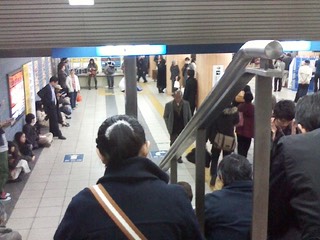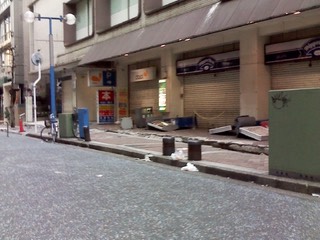Last week I went to Japan as I often do at the beginning of the spring break at Yale. I pay my taxes, do some research, consult with people about projects at Yale, etc. I was actually meeting Tsuchimoto Motoko, the wife of the great documentarist Tsuchimoto Noriaki, for lunch on Friday, 11 March 2011, at a sobaya on the eighth floor of the Takashimaya department store at Yokohama Station. My wife is putting out DVDs of some of Tsuchimoto's work.
It was at 2:46 pm when the quake hit. One gets used to earthquakes in Japan, so at first we just felt it was just another minor trembler. But the shaking got worse and worse and went on and on. I was in Kyoto when the Kobe earthquake occurred in 1995, and that quake started violently, suddenly, and lasted only about 20 seconds. This started slowly and seemed to go on forever, giving you plenty of time to wonder when the building is finally going to fail. Afterwards I found out that Yokohama experienced shaking of Shindo 5- or 5+, which is pretty serious. Motoko-san and I hid under the table. The department store immediately announced the quake on the PA system and provided warnings. It took too long, but finally the shaking died down and Motoko-san and I left the building via the stairs. There was a huge crowd in front of Yokohama Station as many people had fled the nearby structures.
It was quite clear this was a huge quake, one probably not centered in Yokohama. There was a big aftershock within about 20 minutes and people fled to the bus circle in front of the station. The trains had stopped, but with people in the roads, the traffic had stopped too. I couldn't make a call on my cell phone, but I could use the internet to see that this was a historic quake that struck off the coast of Miyagi Prefecture.
Motoko-san and I sat by the department store for about an hour waiting for the trains to resume. We were happy to be alive and we shared the experience with others - it is at these times that you can easily talk to strangers. But it was soon clear the trains were not going to start soon, so we parted. I figured the Yokohama Municipal Subway would begin sooner than JR, so I sat down at that part of the station. There soon was an announcement, however, that Yokohama City had told everyone to walk home.

I knew that walking home could always be a possibility if a big quake hit, but I was not expecting to have to do it from Yokohama Station. While most people were still milling around, I decided to do it and quickly went to a station kiosk and bought a map, some water, and some candy to eat along the way. I then started out on a trek that eventually took about four hours.
First walking through the area near the station, I could see there was structural damage even here. There was a small crevice formed in front of a building near Tokyu Hands.

I kept walking, going up the hill towards Mitsuzawa Park. I wondered whether I shouldn't pick a route that went near a train line so that I could check at stations along the way whether the trains were running, but that would have involved a longer, more circuitous route, so I picked one that was shorter (I later checked on Google and saw I did pick the shortest route). But that involved going up and down a number of big hills for the first few kilometers. Lugging a heavy computer, I began to worry whether I could do this. And at first, there were not that many people walking, so I sometimes wondered whether I was not just the only one in the entire city who was foolishly walking home. I still couldn't make any calls on my phone, though I could use it to send short e-mails to my family and check some short internet articles.
The sun set and it got dark. The area I was walking in still had lights, but just before I reached Kamoi Station, I encountered an area that was suffering from a power outage. The street in front of the station had power, but the station house did not. It was closed and there were a lot of people milling around waiting for a bus or taxi. I decided to keep on walking, but from that point on, the entire area was pitch black except for the lights from passing cars. By this time there were a lot of people walking along with me. It was quite surreal, all of us walking through major urban areas with no lights. I couldn't even check my map at first because there wasn't enough illumination.
But everyone was calm and took the experience in stride. You could see local volunteers directing traffic at intersections using flashlights. There were a few factories along the way with their own generators that had lights I could use to check my map.
I finally reached Nakayama Station and it was pitch black. I used a public toilet in the dark and wondered whether I shouldn't wait for the bus that goes from Nakayama to Aobadai Station. But there were no buses in sight and a long line had formed of people waiting. So I decided to walk. I was lucky, however. After a few hundred meters, I ran into a taxi and quickly flagged it. Up until that point, I had walked about 12 kilometers, but was able to go the last 4 by taxi. The traffic was dense, and the going was slow, but I finally made it to Aobadai after 8 pm. Luckily, the area around the station had power. I ate a bit, got on my bike, and went home. Fortunately there was not much damage there.
I felt lucky. The images I finally saw on TV were horrifying. This was terrible catastrophe that made anything I experienced miniscule in comparison.
Yet I had a plane to catch the next day. And the news about the reactors in Fukushima got worse and worse. The transportation to the airport was a mess on Saturday: some of the trains had started, but at first none were going to the airport. It was clear there was no way I was going to make my plane, so I quickly decided to change flights. I was lucky to get one the next day and then just set out, determined to get to the airport whatever way I could and stay the night at a hotel. What usually takes about 2 hours took about 5 1/2, as there were few trains and you had to switch trains quite a lot because there was no real schedule and some trains only went part of the way. I also had to wait a long time for a taxi at Narita Station.
At the hotel, I quickly learned of the first explosion at the Fukushima reactor. There was no official information from the government, so for a few hours, there was nothing but speculation on TV and one could easily begin fearing for one's life. False rumors were also being spread by internet. I could only relax a bit when Edano finally got on TV to explain what was going on. (My impression has been that Japanese news coverage has been pretty calm and rational, whereas the foreign news, especially CNN, has been overly alarmist.)
Narita was very crowded, but I boarded my plane with no problem and arrived back home in Connecticut on Sunday. It's good to be back in the bosom of my family.
But my heart goes out to my friends and family in Japan. Motoko-san had to walk nearly 12 hours to get back to Fujisawa. All my immediate friends and family are safe, but the grandmother of a friend is missing. I worry every moment about the potential consequences of the nuclear accident and am not getting much sleep. My wife and I watch Japanese TV on Ustream, and pray for the quick rescue and recovery of people in the other areas hit by the quake.
I urge everyone to donate to the earthquake relief. The Japan Society in New York is helping organize donations. Please donate here.
I was interviewed by the Waterbury Republican-American about my experiences. I don't subscribe, so I cannot check to see if they got it right.
Japan is the place I love, study, and make one of my homes. I ask all of you to join me in prayer for its safety and quick recovery.

